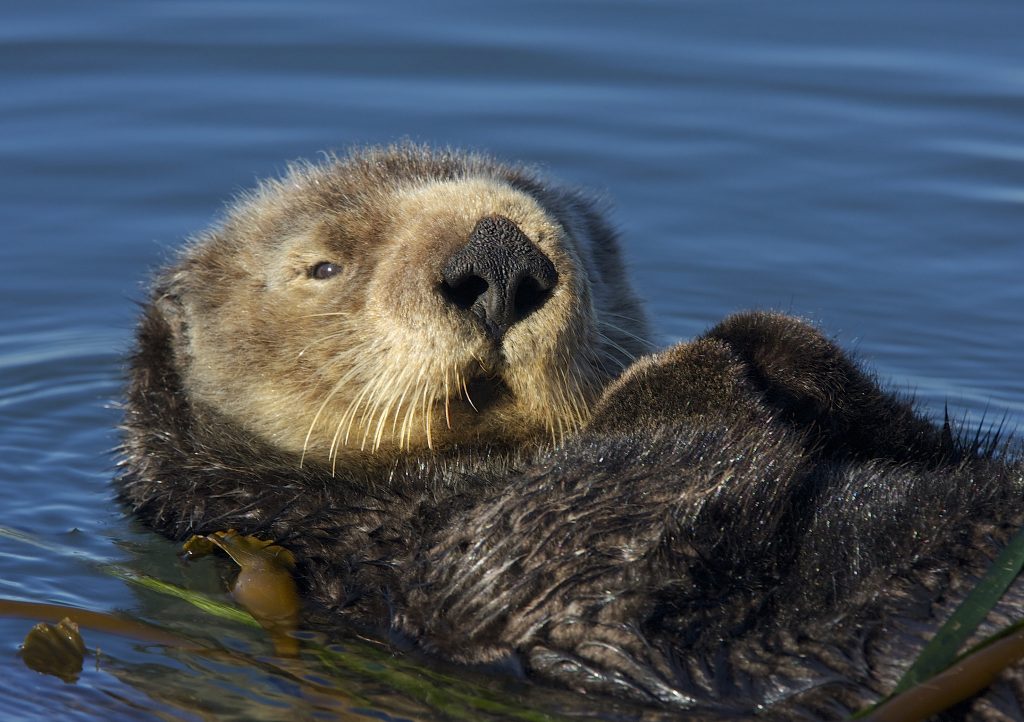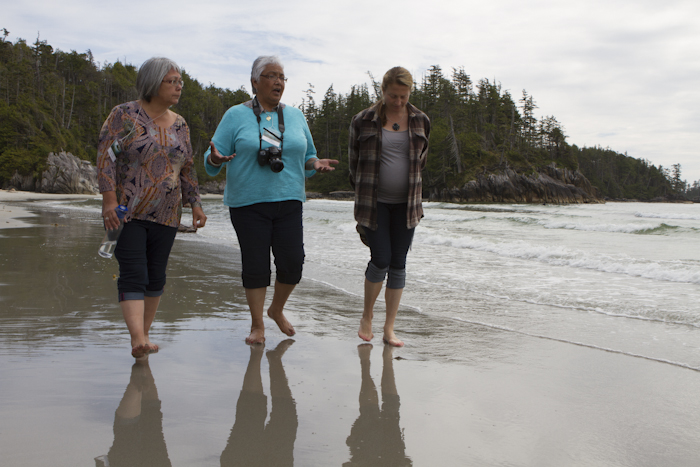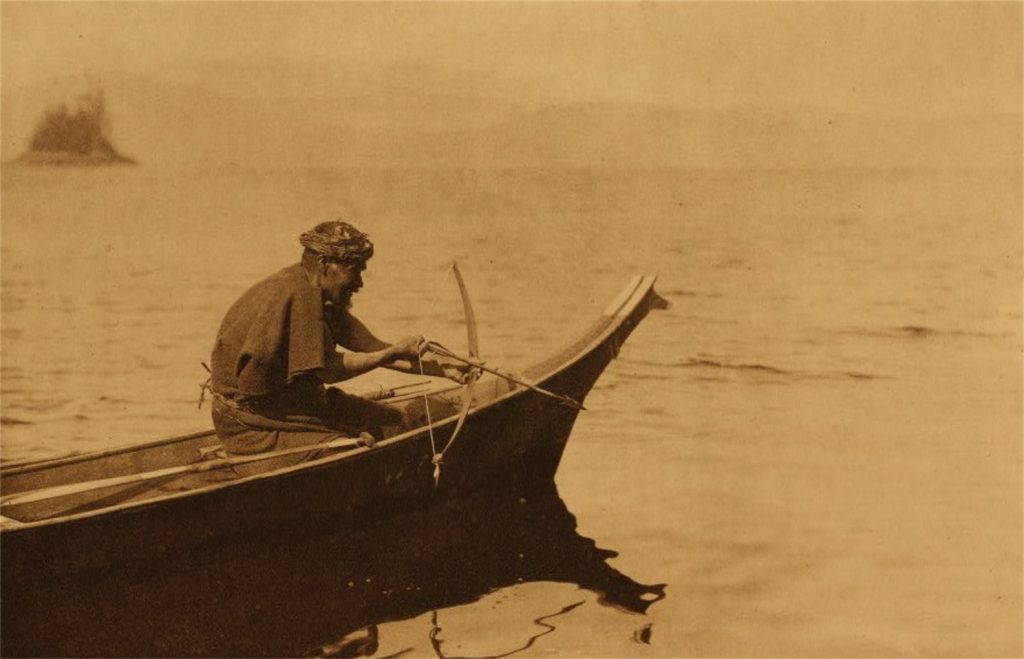Seafood Fight

On the wild west coast of Vancouver Island, the tiny hamlet of Kyuquot lies nestled in the folds of British Columbia’s rumpled shoreline. It’s a wilderness paradise with a population of a few hundred, and the First Nations peoples have lived here, or in similar coves nearby, for thousands of years. So have sea otters. But despite millennia of co-existence, the two are now embroiled in conflict. And what sounds like a heartwarming ecological success story—the booming recovery of adorable sea otters in an area once decimated by the fur trade—is the source of that discontent.
“There are a lot of negative thoughts about otters,” says Danny Short, a First Nations fisheries worker in Kyuquot who has experienced the otter boom firsthand. “Some people just shoot ’em just to shoot ’em,” he says. “But the Creator put them here. I’d rather see them around.”
The fur trade of the 18th and 19th centuries spurred a hunting spree that wiped sea otters off the map, with a global population of hundreds of thousands plummeting to just a few thousand. Tens of thousands of otter pelts were harvested from the waters around British Columbia alone, with the last known otter in those parts shot in 1929. In an attempt to kick-start a new population, conservationists relocated 89 otters from Alaska to Kyuquot between 1969 and 1972. The scheme worked. Today there are at least 5,500 otters in British Columbia, though so far they have only repopulated about a third of their former territory (most are in two hotspots: around Kyuquot, and on the central British Columbia coast halfway between the islands of Haida Gwaii and Vancouver Island). In 2009, sea otters were down-listed by authority of the Canadian Species at Risk Act from “threatened” to the gentler designation of “special concern.”
But good news for otters is bad news for sea urchins, clams, abalone, and more. Otters, with their slim, no-blubber physique and high metabolism need to eat an astonishing amount to stay warm in the frigid waters of the northern Pacific—about a quarter to a third of their 100-pound body weight each day. “If you see an otter, it’s probably eating,” laughs Anne Salomon, a marine ecologist with Simon Fraser University in Vancouver. Thanks to both overfishing and the otter boom, abalone have made it onto the “endangered” list. All the shellfish are sorely missed by coastal communities accustomed to harvesting them for food or sale. “The kids used to go out and dig for clams,” says Short. “It was a real family-oriented thing. But not anymore.”
Don Hall, fisheries program manager for the Nuu-chah-nulth tribal council, which represents 14 First Nations along the coast, including the Kyuquot, remembers a big fight in the early 1990s with commercial fishermen over crabbing rights. “Well, five years later there [was] no commercial crabbing or anything,” says Hall, “because sea otters [had] come in and really cleaned it out.”
All this has led to heated debates about whether to celebrate the otters’ recovery or hunt them—or both. While many conservationists are thrilled with the animals’ population boom, many who rely on shellfish for sustenance are not. “People aren’t always happy with conservation efforts because that’s an imposition on their daily lives,” says Iain McKechnie, an anthropologist at the University of Victoria, British Columbia, whose work has helped to assess what the otter population was like long before the fur hunt. The work of McKechnie, Salomon, and others is now helping to untie the tangled links between otters, shellfish, and people, to help determine what a long-term sustainable relationship might look like.
It isn’t smooth sailing. In June 2014, Salomon spearheaded a unique meeting of scientists and First Nations chiefs to hash through some of these issues. “It was really risky. I had invited some of the biggest egos in science, and some of the biggest personalities in First Nations governance and politics,” Salomon says. “It could have been a complete shipwreck.”
Sea otters can be found in coastal Pacific waters from northern Japan to the central Baja California Peninsula of Mexico. For many tribes scattered up and down the coast, the histories of sea otters and people are deeply entwined. For the Alutiiq people of southern coastal Alaska, for example, they are one and the same: The original sea otter, their legends say, was a man trapped by an incoming tide, who transformed into an otter to save himself.
Archaeological evidence shows that people have been living on British Columbia’s west coast for more than 10,000 years, and sea-otter hunting was an important part of that entire history. Before Europeans arrived, native peoples prized thick otter pelts for ceremonial robes, bedding, and insulation; the lack of blubber that makes otters so needy of food means that they instead possess a luxuriously thick, warm coat of fur.
Evidence suggests that local peoples managed their otter populations in accordance with the Nuu-chah-nulth principle of Hishuk Ish Tsa’walk, meaning “everything is one, everything is interconnected.” Oral histories of the Nuu-chah-nulth tell that only certain people were allowed to hunt otters at certain times of year. In addition, hunters may have specifically targeted the more adventurous male otters, since these are the animals that typically expand their territorial range. Otter remains found in archaeological middens—buried piles of shells and other domestic garbage—suggest there was a fairly even take of the animals over time, indicating that otter populations didn’t boom and bust but stayed relatively stable.
The fur trade changed everything. It created an “unprecedented ecological shift,” says Salomon. Otters are a vital part of a healthy, thriving, kelp-forest ecosystem. When otters were taken out of the ecosystem, the urchins boomed and mowed down the “old growth” kelp forests, removing a safe haven for fish to spawn, eat, and hide from predators.
McKechnie’s work has involved digging up otter bones from middens and looking at their isotopic content to try and pin down what those otters were eating. A study of ten sites spanning from about 5,200 years ago until 1900 found that sea otters in northern British Columbia had stable diets rich in shellfish, again hinting that locals were probably keeping the otters in check. In areas where otters are instead left to breed unrestricted, they eat urchins and allow kelp forests to thrive; researchers have found that kelp forests today are nearly 20 times larger in areas with otters than in areas without. And when kelp forests flourish, fish become a bigger part of the otters’ favored food.
Such archaeological work isn’t easy. Middens can provide a wonderful peephole into history: Hiding beneath unimposing grass and shrubs one can find garbage pits sometimes meters deep and up to a kilometer long, holding stone tools, shells, and bones that reveal ancient eating and living practices. But these middens aren’t just trash heaps; the bones of ancestors may be mixed in with the bones of ancient foods. And many communities are wary of how those human remains will be treated by researchers, given a long history of colonial settlers doing as they please in traditional lands. “We’re working with what many people consider sacred,” says McKechnie. “Some nations don’t want people messing around in their history.”
McKechnie says he and his colleagues are happy to collaborate with tribes on these sensitive issues; the thing that really slows their work is the small number of researchers in the field and their small pot of funding. Together they are picking away at a massive area of potential study: There are thousands of known midden sites in British Columbia, less than 1 percent of which have been excavated.
Although First Nations peoples seemingly lived in balance with otters for millennia, much of that is now a distant memory. “Even some of our elders who are 70 or 80 years old never grew up with otters,” says Short, the First Nations fisheries worker in Kyuquot. “Their grandparents did. But then they were the currency for the West Coast.” More recent generations have grown accustomed to eating shellfish and now resent otters for stealing their food. “You tell the Nuu-chah-nulth that they didn’t have urchins in their diet 200 years ago,” Hall adds, “and people say, ‘I don’t care. I like eating sea urchins now.’”
For Hall and Short, the trick is to convince locals they have something to gain by allowing otters to come back. “We try to tell people,” says Hall, “‘Look, otters are a part of the ecosystem, and in the long term you’re better off. There are other things in your diet that will benefit from a healthy ecosystem, like fish, and some shellfish too.’” Short says he has seen that relationship play out in Kyuquot. “The otters have revived the ecosystem,” he says.
Salomon is helping to pin down the details of that revival. Since 2010, she has been working with the Heiltsuk Nation of British Columbia’s central coast—the second hotspot of otter recovery—to compare sites where otters have lived for one to three decades with sites where they only arrived a few years ago and those where otters have yet to move in. These studies show that kelp comes back to an otter-populated area after about three years, but it takes roughly 20 years for an old-growth kelp forest to get established. “That’s a hell of a lot shorter than old growth on land, so we should thank our good graces for that,” Salomon says.
Kelp growth alters the amount of light filtering into the water and provides food for seals, spawning grounds for herring, and protection for rockfish. While more kelp doesn’t necessarily translate into more of everything, Salomon’s as-yet-unpublished work shows a spike in copper rockfish—one of the local fish that happens to be good to eat and easy to catch. Studies elsewhere show similar trends: Jim Estes, a biologist at the University of California, Santa Cruz, and one of the world’s foremost experts on sea otters, found in Alaska in 2005 that kelp forests in areas with healthy otter populations hosted up to 10 times more rock greenling—the most prevalent fish in the region—than areas where urchins had mowed down the kelp. For the people who rely on these waters for their food, more fish should help to offset the pain of losing easy-to-harvest shellfish.
Beyond numbers, researchers are reaching out with video and stories to help spread the message of healthy ecosystem recovery and how that should benefit local communities. McKechnie remembers visiting Kyuquot a few years back with a colleague who was taking video footage of his research. “He was diving with a GoPro and could show the vibrant marine life and the kelp beds, plugged into a big screen in someone’s living room,” he says. “It’s such a powerful thing to watch someone see for the first time just how amazing the life is in their own backyard.” Salomon’s work, which is funded by the Pew Charitable Trust, a nonprofit organization based in Philadelphia, will help to spread results through a First Nations touring art exhibit and a multimedia, interactive photo-journal.
But no matter how pointedly or sensitively the news is spread, the decades-long ecosystem transition makes locals uneasy. “It’s a long-term recovery to animals and fish that you haven’t had in a long time,” says Hall. “The question is whether you can shorten that period of pain.”
Salomon says that speeding up ecosystem recovery is unlikely, but locals can learn to manage otters to ease the transition. For instance, in Alaska, where Salomon worked previously, communities ran boats around beaches where the locals harvested black chitons, snails, and octopuses, to scare the otters away. “People might have used dogs in the past,” she says. Another approach to otter management would involve some sort of regulated hunt.
Otter hunting is a touchy issue. Outsiders who don’t rely on the ocean for their living are repelled by the idea of killing such charismatic creatures. But a hunt or cull sounds reasonable to locals who are watching their clam dinners get wiped out. “They’re not so cute after you’ve been living with them for a few years in your front yard,” notes McKechnie. Plus, a managed hunt would allow First Nations peoples to respect their ancient customs and “cloak the chiefs in sea otter pelts” again, notes Hall.
Some conservation scientists take the view that ecosystems should be pristine, without human impact, says Salomon. But, she adds, most now agree that people should be considered as part of the ecosystem, not as outsiders. “I think most people realize we need to consider balancing the needs of both nature and human beings.” At their 2014 meeting of scientists and First Nations representatives, she says, “That agreement was very clear, from both sides.”
In 2012, the Nuu-chah-nulth wrote a draft otter-management plan that included otter hunting for ceremonial purposes, including a proposed harvest number, says Hall (in 2007, Canada’s Department of Fisheries and Oceans recommended a total allowable kill, including hunting and accidents, of 143 otters per year). But the Nuu-chah-nulth council haven’t actually applied for a hunting permit yet. “That hasn’t been finalized because there are other priorities right now,” says Hall—the Nuu-chah-nulth are currently embroiled in a court battle to stop the Canadian federal government from reopening commercial herring fisheries in waters where the herring are depleted and the Nuu-chah-nulth have traditional fishing rights. Besides, adds Salomon, “even the act of applying for a permit is disempowering.” Many First Nations peoples don’t recognize the authority of the Canadian federal government, or see why it should have a say in their ecosystem management or traditional practices.
In the meantime, some otters are being culled in British Columbia anyway. Short knows of a limited harvest of about 11 otters a few years back, he says, and scientists have seen the carcasses of otters that have been shot. Though such culling is illegal according to Canada’s laws, says Salomon, it is in accordance with First Nations practices.
Salomon notes that earlier this summer in Bella Bella, a tiny town within the central British Columbia–coast otter hotspot, she helped a young First Nations man to deal with the carcass of an otter that had been shot by an elder chief. “This young man was really upset,” says Salomon. “There’s conflict within the village about what’s morally right, and ecologically right. The elder is fishing for his family; the young guy is probably getting most of his food from the grocery store.”
The good news is that this generational difference in needs and attitudes might make it easier for the young people, and the next generation of leaders, to accept a loss of shellfish in exchange for a managed otter population with kelp forests and fish. With some data and information about how things used to be long ago, the affected communities can come to informed decisions about how to live with otters going forward. “The transformation is hugely painful,” says Salomon. “I think information sharing can increase their capacity for change.”



































